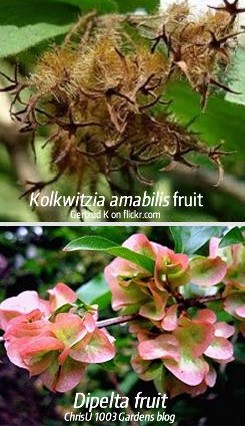
Q: How can I tell the difference between
Weigela, Dipelta, and
Kolkwitzia?
A: All three of these opposite-leaved shrubs are in the honeysuckle family, Caprifoliceae. However, some taxonomists split
Kolkwitzia and
Dipelta (along with
Abelia and
Linnaea) into Linnaeaceae, while
Weigela joins
Diervilla in Diervillaceae.
Although spring is the time when most plant lovers notice these flowering shrubs, it is easier to tell them apart when they develop dry fruit.
Dipelta floribunda and
Kolkwitzia amabilis produce achenes (dry, single-seeded fruits that do not split open), whereas
Weigela florida fruits are capsules (clustered together like a tiny bunch of bananas, and developing from green or red to brown as they mature).
Dipelta bracts are ornamental, papery, and colorful before they dry to brown.
Kolkwitzia bracts are weird-looking, like bristly chicken feet.
If you are eager to know what you are looking at while the shrub is still in flower, it is easy to rule out
Dipelta and
Kolkwitzia if the flowers are red or yellow, in which case, it's
Weigela. Bear in mind that
Kolkwitzia and
Weigela are common in home gardens, while
Dipelta is much less so.
Dipelta and
Kolkwitzia have pale pink to whitish flowers with markings on the petals;
Weigela lacks such markings.
Weigela petals also differ from the other two genera in that they are all about the same size (radially symmetrical, or actinomorphic), while in
Dipelta and
Kolkwitzia, the lower petals are larger than the upper two (that is, bilaterally symmetrical, or zygomorphic). The bristly characteristics of
Kolkwitzia that are so notable in the dried fruit are also visible in the white bristles at the flower’s base. The
Dipelta flower's base is concealed between a pair of circular bracts. To summarize: Bananas?
Weigela. Bracts?
Dipelta. Bristles?
Kolkwitzia.
Sources:
To see pictures of the nearly-identical flowers of Kolkwitzia
and Dipelta
, see the Gardening Answers Knowledgebase entry for this question.